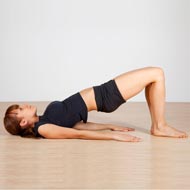- Aromatherapy (36)
- Benefits of Yoga (282)
- Home Remedies (1087)
- massage therapy (9)
- Preventive Therapy (135)
- Running (41)
- Skin Care (15)
- Stress Relief (25)
- Stretching (5)
- walking (33)
- Womens Health (14)
- Yoga Benefits for Pregnant Women (16)
- Yoga Benefits for Students (3)
- Yoga for Children (11)
- Yoga for Holistic Living (37)
- Yoga for Midlife Crisis (3)
- Yoga for Senior Citizens (2)
- Yoga for the Workplace (1)
- Yoga Health Tips (185)
- Yoga Practice during Menstruation (5)
Recommended Yoga Postures After Hip Replacement

You can definitely practice yoga even after hip replacement, but a word of caution needs to be introduced. The postures that you can do, and how well you can do them, vary from person to person. It also depends on your level of fitness, strength and flexibility not only overall, but also specifically in the hip region. It also depends upon the type of surgery you have had – whether you have had multiple dislocation, partial hip replacement and so on. It is always better to ask your doctor before starting.
It is also advisable that you start slowly with easy exercises and graduate to more difficult ones as your body recovers. Keep in mind that your body is the best judge, and listen to what it tells you. Some of the exercises may also have to be modified to suit you.
The yoga asanas (poses) will help tone up and strengthen the muscles, which have been weakened after having undergone surgery. They will also help to improve flexibility which may have been lost due to an artificial implant. Since the postures encourage greater intake of oxygen, and improved blood circulation, more oxygen-rich blood will be delivered to all parts of the body, especially the area which has been traumatized by surgery and lead to quicker and better healing. Larger quantities of oxygen and reduction in stress levels also induce a feeling of well-being, which again leads to better healing.
Yoga Postures After Hip Replacement
All standing postures are good for stabilizing the hip joints after surgery. These could include the:
Tree Pose (Vrkasana), and Bridge Pose (Setu Bandha Sarvangasana)
Backbends:
- Boat Pose (Navasana) - you may need to use a block between the thighs)
- Mountain Pose (Tadasana) – you may need to use a block between the upper thighs
- Warrior I (Virabhadrasana) – but be careful not to stretch beyond 90 degree hip flexion
- Warrior II (Virabhadrasana) - but be careful not to stretch beyond 90 degree hip flexion
- Cobra (Bhujangasana)
- Crocodile Pose (Makrasana)
- Half Moon Pose (Standing Ardha-chandrasana)
- Cat-Cow Pose
- Forward facing Triangle Pose (Trikonasana)
- Dancer Pose (Natrajasana)
- Upright Dog Pose (Urdhva Mukha Svanasana)
- Bound Angle Pose (Baddhakonasana)
- Staff Pose (Dandasana)
- Modified Half Locust Pose (Ardha-salabhasana):
- Seated Wide Angle Pose (Upavishtakonasana)
- Reclining Bound Angle Pose (Suptabaddhakonasana)
- Corpse Pose (Shavasana) Use support under the head and the knees.
These exercises will help you flex the muscles of hips, knees and ankles, and activate them. By opening up the muscles, they provide relief and strengthen them.
Start with the standing exercises and do not try to sit down in the beginning. However the moment you feel any discomfort or resistance, stop immediately. Do not go beyond 45 degrees where bending is required. And make use of blocks, straps, pillows and blankets to facilitate the movements.
- RSS Feeds -
- All posts
- All comments
- Yoga to Balance the Doshas Typically, it is believed that there are five key elements that make up t...
- Exercises for Injured Knee A knee injury may take considerable time to heal completely. As with any othe...
- Lower High BP With Yoga High blood pressure is one of the most prevailed ailments in the world right ...
- Teach yoga When you teach yoga, you will enable students to increase their strength and fle...